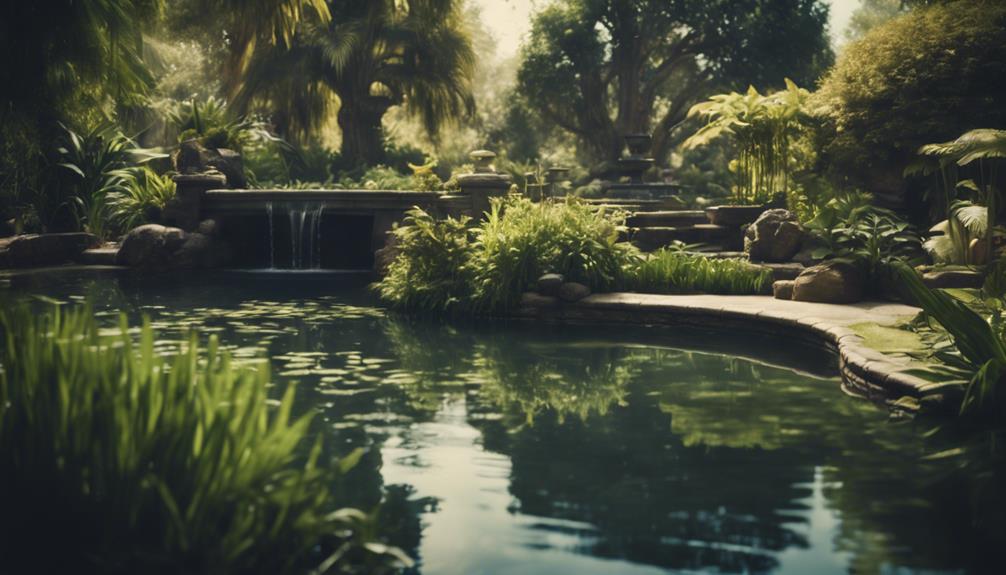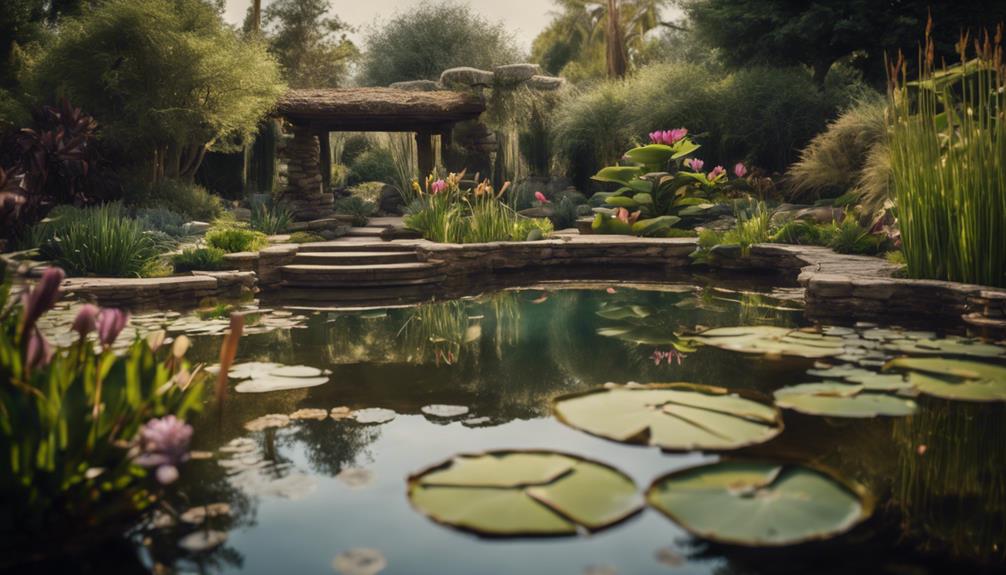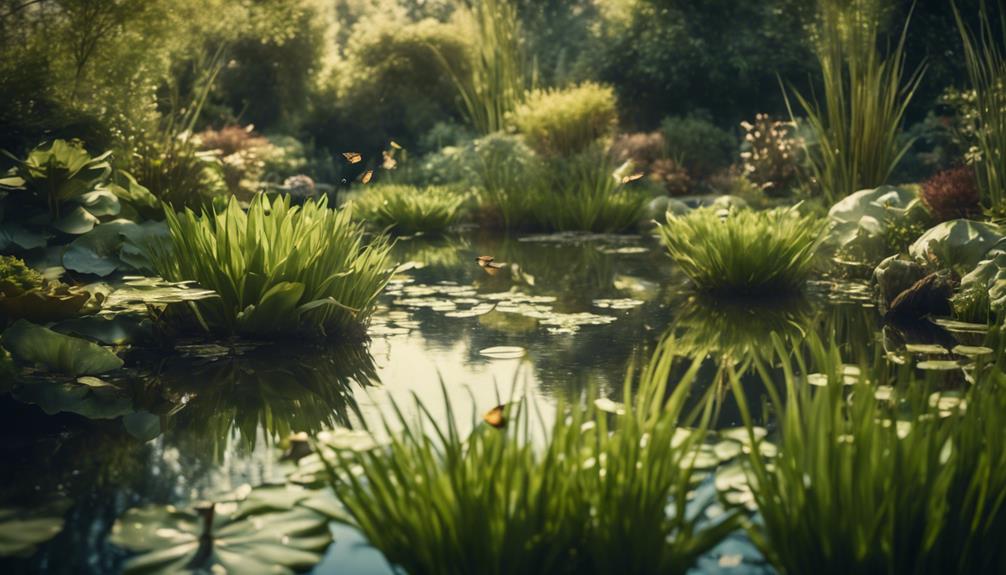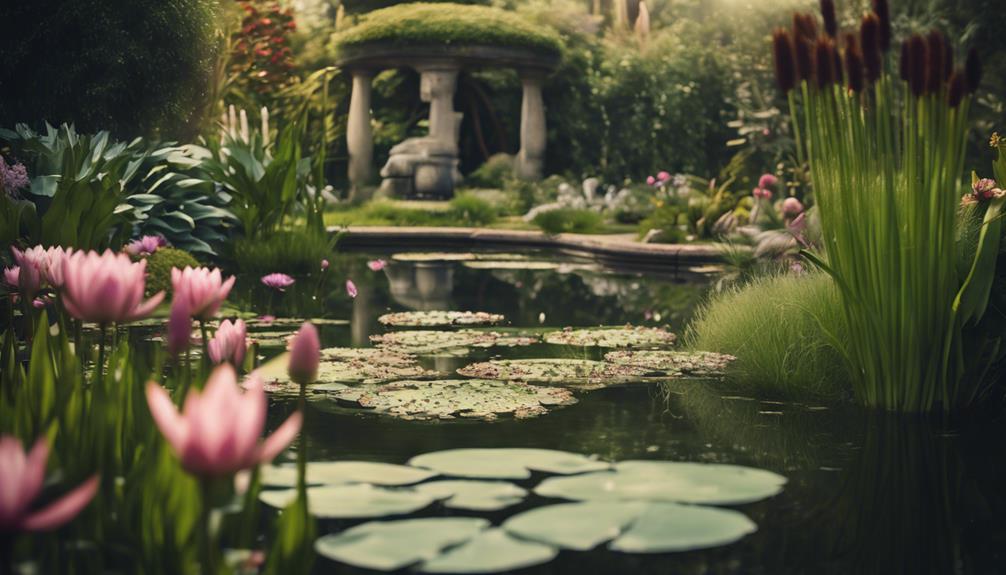You can transform your garden oasis design by incorporating aquatic plants with unique textures, colors, and growth habits. Combine foliage with varying textures, such as smooth, glossy, and matte, to add depth and dimension. Water features like ponds, fountains, and bubblers create soothing sounds and visual interest, attracting wildlife to your garden. Consider sunlight, water circulation, and aquatic life when designing a water feature that complements the surrounding landscape. By carefully selecting and maintaining aquatic plants, you'll create a thriving ecosystem that invites relaxation and exploration. As you continue, discover the secrets to crafting a harmonious haven that's both visually stunning and ecologically balanced.
Table of Contents
Key Takeaways
- Incorporate aquatic plants with unique textures and colors to create visually appealing contrasts in your garden oasis design.
- Combine different foliage textures, such as smooth, glossy, and matte, to add depth and dimension to your water garden.
- Select aquatic plants that complement the overall aesthetic and provide habitat for aquatic creatures like fish, frogs, and turtles.
- Incorporate natural elements like rocks, driftwood, or water features to add texture and visual interest to your garden oasis.
- Design a cohesive look by integrating the water feature with the surrounding landscape and incorporating aquatic plants that thrive in it.
Foliage and Texture Essentials
As you envision your garden oasis, remember that foliage and texture are essential components that can elevate the space from ordinary to extraordinary.
When it comes to incorporating aquatic plants, you'll want to weigh options that offer unique textures and colors to create a visually appealing contrast.
'Poquito Banana' and 'Black Ripple Colocasia' are great options, boasting lush foliage and robust architecture that add depth and dimension to your garden.
For a lacy touch, 'Soft Caress Mahonia' and 'Obsession' Nandina provide delicate foliage that creates a beautiful contrast to more robust plants.
'Design-A-Line' Cordyline adds a pop of color and movement with its long, linear leaves, while 'Spiders Web Fatsia' provides year-round interest with its broad, deep-cut foliage.
By combining different foliage textures, such as smooth, glossy, and matte, you'll create a visually appealing contrast that adds depth and dimension to your garden oasis.
With these aquatic plants, you'll be well on your way to creating a stunning and unique space that reflects your personal style.
Vibrant Colors and Tropical Vibes
As you design your garden oasis, you'll want to incorporate plants that evoke the essence of the tropics.
To achieve this, you'll focus on selecting plants with tropical foliage accents, vibrant color schemes, and lush texture depths that'll transport you to a serene paradise.
Tropical Foliage Accents
Your tropical oasis comes alive with the vibrant, architectural foliage of 'Poquito Banana' and 'Black Ripple Colocasia', which transport you to a lush, exotic paradise.
These plants embody the look of the tropics, adding a touch of drama and sophistication to your water garden.
To create a visually striking display, select plants with varying textures and forms, such as 'Soft Caress Mahonia' and 'Obsession' Nandina, which add a lacy touch with their delicate and intricate leaf patterns.
'Design-A-Line' Cordyline is another great option, providing color and movement with its long, linear leaves that come in a range of colors.
For year-round interest, incorporate 'Spiders Web Fatsia', which provides evergreen color with its broad, deep-cut foliage that resembles a spider's web.
By incorporating these tropical foliage accents, you'll create an enthralling and immersive experience in your garden oasis.
With vibrant colors and exotic textures, your water garden will be transformed into a tranquil retreat that invites relaxation and serenity.
Vibrant Color Schemes
Beyond the dramatic foliage, vibrant colors take center stage in your aquatic garden, where hot hues of red, orange, and yellow can be strategically used to create a tropical atmosphere that draws the eye to specific areas of the space.
You can incorporate plants like 'Poquito Banana' and 'Black Ripple Colocasia' to add a pop of color and texture to your aquatic oasis. These vibrant colors won't only enhance the visual appeal of your water feature but also stimulate plant growth.
To add some contrast, introduce lacy plants like 'Soft Caress Mahonia' and 'Obsession' Nandina, which will complement bold colors with delicate foliage.
For a dynamic and exotic atmosphere, use 'Design-A-Line' Cordyline to create long lines of color and movement.
Finally, 'Spiders Web Fatsia' provides evergreen color with its broad, deep-cut foliage, adding depth and visual interest to your aquatic oasis.
Lush Texture Depths
By combining plants with varying textures, you can create a lush, dimensional quality in your aquatic oasis, where vibrant colors and tropical vibes come alive through the interplay of smooth, ruffled, and deeply cut foliage.
'Poquito Banana' and 'Black Ripple Colocasia' plants embody the look of the tropics, with their bold, statement-making leaves.
Meanwhile, 'Soft Caress Mahonia' and 'Obsession' Nandina add a lacy touch, their delicate fronds dancing in the breeze.
'Design-A-Line' Cordyline injects color and movement, its long lines creating a vibrant and dynamic atmosphere.
'Spiders Web Fatsia' provides evergreen color with its broad, deep-cut foliage, adding a lush and tropical feel.
By incorporating these plants with varying textures, you'll create a rich, layered look that invites exploration and discovery.
As you wander through your aquatic oasis, the lush texture depths will envelop you, transporting you to a tropical paradise where plants and fish thrive together in harmony.
The Power of Water Features

As you step into your garden oasis, the gentle lapping of water against the shore or the soft gurgle of a fountain immediately captivates your senses, drawing you into a serene and peaceful atmosphere. Water features, such as ponds, fountains, and bubblers, can add visual interest, create soothing sounds, and attract wildlife to your garden oasis, thereby increasing its tranquility and aesthetic appeal.
| Benefit | Description |
|---|---|
| Visual Interest | Add a focal point to your garden oasis with a visually appealing water feature |
| Soothing Sounds | Create a calming atmosphere with the gentle sounds of water flowing or bubbling |
| Wildlife Attraction | Attract birds, butterflies, and other wildlife to your garden oasis with a water feature |
When designing a water feature, it's vital to deliberate factors such as sunlight, water circulation, and aquatic life to guarantee a thriving ecosystem and minimize maintenance needs. By incorporating a water feature into your garden design, you can create a peaceful retreat that not only relaxes your mind but also enhances the overall ambiance of your outdoor space.
Designing a Cohesive Look
To create a visually stunning garden oasis, you'll want to focus on designing a cohesive look that seamlessly integrates your water feature with the surrounding landscape, incorporating aquatic plants that complement the overall aesthetic.
By doing so, you'll create a harmonious blend of elements that work together to produce a breathtaking atmosphere.
To achieve this, consider dense planting with aquatic plants like 'Poquito Banana' and 'Black Ripple Colocasia' to add a lush, tropical feel.
Add movement and color with 'Design-A-Line' Cordyline, and contrast it with 'Spiders Web Fatsia' for a visually appealing effect.
Accent your foliage with hot colors like red, orange, and yellow to create a tropical ambiance, and incorporate aquatic plants with similar hues to enhance the overall aesthetic.
Expert Insights and Tips

As you create your garden oasis, you'll want to focus on the essential elements that bring it to life.
To guarantee a thriving aquatic ecosystem, you'll need to ponder the must-haves for your water garden, as well as how to design for harmony and visual appeal.
Water Garden Essentials
In crafting a serene water garden oasis, you'll need to incorporate essential elements that work in harmony to create a thriving ecosystem.
As you design your water garden, it's pivotal to prioritize the well-being of your aquatic plants, as they play a pivotal role in maintaining water quality and ecological balance.
To achieve this delicate balance, consider the following essential elements:
- Aeration: Providing adequate oxygen levels for your aquatic plants and fish is vital. Aeration systems can help increase oxygen levels, reducing stress on your aquatic life.
- Filtration: A proper filtration system helps remove waste and excess nutrients, maintaining crystal-clear water and preventing the growth of algae.
- Water Circulation: Adequate water circulation is necessary to confirm that your aquatic plants receive the necessary nutrients and that waste is efficiently removed.
Designing for Harmony
By thoughtfully selecting and arranging aquatic plants, you're creating a harmonious visual balance that not only pleases the eye but also supports the overall health of your water garden ecosystem. To achieve this harmony, consider the following expert tips:
| Design Element | Tips for Harmony |
|---|---|
| Focal Points | Create visual anchors with statement plants or decorative elements to draw the eye to specific areas of your water garden. |
| Natural Elements | Incorporate natural elements like rocks, driftwood, or water features to add texture and visual interest. |
| Color Palette | Select plants with complementary colors to create a soothing, serene space that promotes relaxation. |
| Plant Height | Vary plant heights to create depth and visual balance, ensuring no single element overshadows others. |
| Negative Space | Don't be afraid to leave some areas of your water garden unplanted, allowing the eye to rest and appreciate the harmonious design. |
Thriving Aquatic Ecosystem
You can foster a thriving aquatic ecosystem in your water garden by understanding the intricate relationships between aquatic plants, fish, and microorganisms.
Aquatic plants, for instance, provide shelter and food for fish, while also producing oxygen and absorbing nutrients that could fuel algae growth. Meanwhile, beneficial bacteria break down organic matter, recycling nutrients for your aquatic plants to thrive.
To create a balanced ecosystem, remember these essential tips:
- Maintain ideal water circulation: Verify that water moves gently, but consistently, to prevent stagnant areas where algae can thrive.
- Monitor water parameters: Regularly test for pH, ammonia, and nitrite levels to guarantee a healthy environment for your aquatic plants and fish.
- Provide adequate hiding places: Incorporate rocks, plants, or other ornaments to give your fish a sense of security and reduce stress.
Planning and Executing a Water Garden
Designing a water garden that fits seamlessly into your backyard requires careful consideration of its size, shape, and overall aesthetic, whether you're working with a compact courtyard or a sprawling landscape.
You can create a thriving water garden by incorporating a recirculating system with a skimmer box, biological filter, and waterfall, which allows you to customize the size and shape of your garden.
Aquatic plants like water lilies and lotus plants not only provide beauty to your garden but also help maintain clear water by absorbing excess nutrients.
To guarantee superior water quality, you'll need to perform regular maintenance tasks, such as removing debris and waste, and using beneficial bacteria to break down waste.
A physical barrier can protect your fish from predators, and filters and skimmers require periodic cleaning.
Daily attention is necessary to maintain a balanced ecosystem, but you can adjust your tasks according to the growing season.
With regular care, your water garden will thrive, providing a serene and dynamic oasis in your backyard.
Incorporating Plants and Wildlife

As you incorporate plants and wildlife into your water garden, native aquatic species like cattails, water lilies, and sedges become essential components, providing shelter and food for the diverse array of wildlife that will inhabit your oasis.
These plants not only add visual interest to your water feature but also create a thriving ecosystem.
By introducing a variety of plant species with different heights, textures, and bloom times, you'll attract beneficial insects and pollinators to the garden.
Native aquatic plants provide habitat for aquatic creatures like fish, frogs, and turtles.
Aquatic plants absorb excess nutrients, reducing algae growth and providing natural filtration.
Planting native aquatic vegetation around the water's edge helps stabilize the soil, reduce erosion, and create a natural-looking progression from water to land.
Maintenance and Upkeep Essentials
Regular monitoring of water quality and plant health is crucial to maintaining a thriving ecosystem in your aquatic garden oasis.
You'll want to regularly test the water's pH, ammonia, and nitrite levels to guarantee they're within the ideal range for your aquatic plants. Also, keep an eye out for signs of nutrient deficiencies or pests that can harm your plants.
As you maintain your aquatic garden, remember to adjust the water level and flow to prevent stagnation and promote healthy plant growth.
Some maintenance tips to keep in mind include removing excess water hyacinth to prevent overcrowding, and pruning plants to maintain a balanced aesthetic.
Additionally, consider incorporating seating areas around your aquatic garden, allowing you to relax and enjoy the serenity of your oasis.
By dedicating time to regular maintenance, you'll be rewarded with a lush, thriving ecosystem that brings you peace and tranquility.
Frequently Asked Questions
How to Turn Your Backyard Into a Garden Oasis?
To turn your backyard into a garden oasis, you'll create a serene ambiance by incorporating garden decor, strategic oasis lighting, soothing water features, and striking focal points, like a statement fountain or vibrant plant arrangement, to craft a tranquil retreat.
How to Make a Water Garden in a Tub?
"Imagine yourself surrounded by serene waters! To create a water garden in a tub, you'll need a deep tub (12-18 inches), placing plants like water lilies in aquatic soil, and maintaining 1-2 inches of water depth for a thriving ecosystem."
How to Make an Aquatic Garden?
You'll create an aquatic habitat by selecting a suitable pond design, incorporating water features, and choosing plants that thrive in your climate, ensuring a harmonious balance that invites serenity and beauty to your outdoor space.
What Is an Underwater Garden Called?
You're curious about the term for an underwater garden, right? It's often referred to as an underwater sanctuary, aquatic haven, submerged landscape, or even a marine ecosystem, evoking a sense of serene tranquility and visual wonder.
Conclusion
As you gaze out at your newly transformed garden oasis, remember that aquatic plants are just the beginning.
Did you know that 70% of the world's oxygen is produced by aquatic plants?
By incorporating these wonders into your design, you're not only creating a serene escape, but also contributing to a healthier planet.
With careful planning and execution, your water garden will thrive, attracting wildlife and mesmerizing all who enter.

